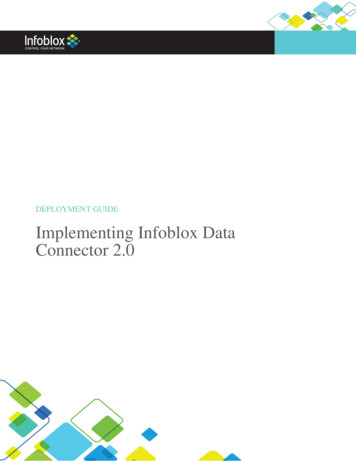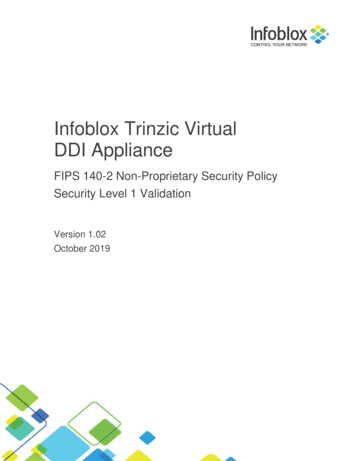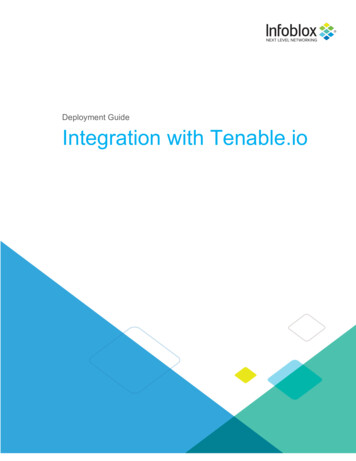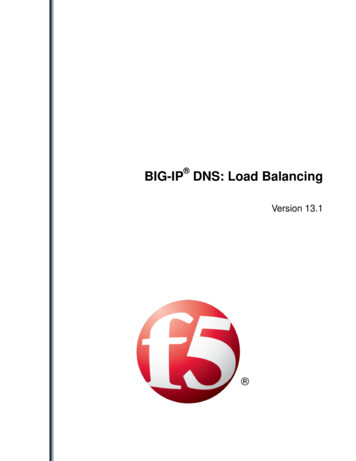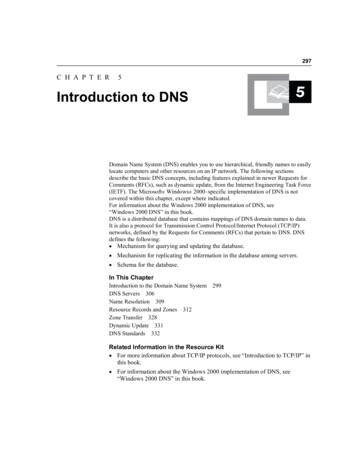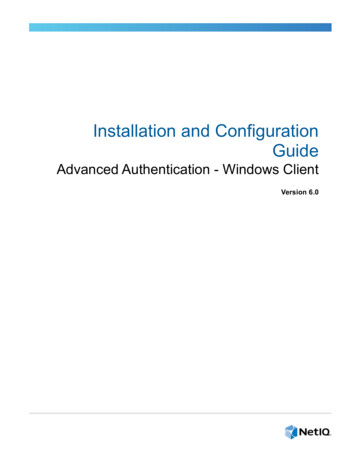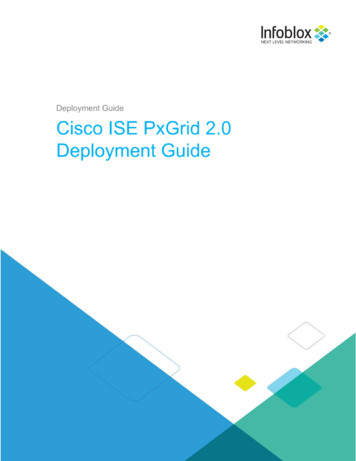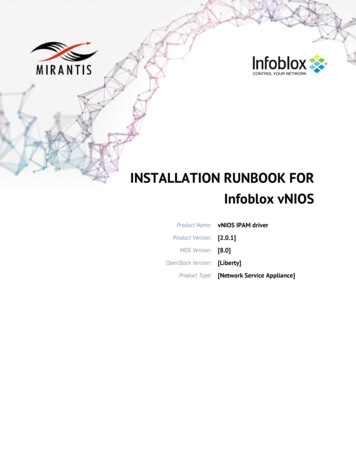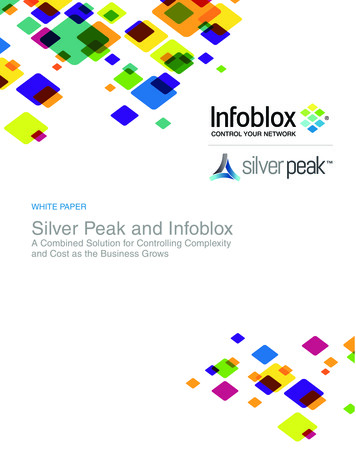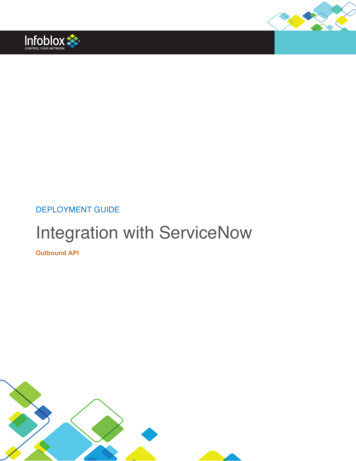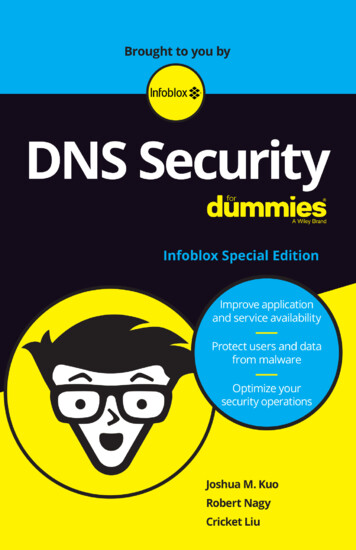
Transcription
These materials are 2018 John Wiley & Sons, Inc. Any dissemination, distribution, or unauthorized use is strictly prohibited.
DNSSecurityInfoblox Special Editionby Joshua M. Kuo, Robert Nagy,and Cricket Liuforeword byCricket LiuThese materials are 2018 John Wiley & Sons, Inc. Any dissemination, distribution, or unauthorized use is strictly prohibited.
DNS Security For Dummies , Infoblox Special EditionPublished byJohn Wiley & Sons, Inc.111 River St.Hoboken, NJ 07030-5774www.wiley.comCopyright 2018 by John Wiley & Sons, Inc., Hoboken, New JerseyNo part of this publication may be reproduced, stored in a retrieval system or transmitted in anyform or by any means, electronic, mechanical, photocopying, recording, scanning or otherwise,except as permitted under Sections 107 or 108 of the 1976 United States Copyright Act, withoutthe prior written permission of the Publisher. Requests to the Publisher for permission should beaddressed to the Permissions Department, John Wiley & Sons, Inc., 111 River Street, Hoboken, NJ07030, (201) 748-6011, fax (201) 748-6008, or online at http://www.wiley.com/go/permissions.Trademarks: Wiley, For Dummies, the Dummies Man logo, The Dummies Way, Dummies.com,Making Everything Easier, and related trade dress are trademarks or registered trademarks ofJohn Wiley & Sons, Inc. and/or its affiliates in the United States and other countries, and may notbe used without written permission. Infoblox and the Infoblox logo are trademarks or registeredtrademarks of Infoblox, Inc. All other trademarks are the property of their respective owners.John Wiley & Sons, Inc., is not associated with any product or vendor mentioned in this book.LIMIT OF LIABILITY/DISCLAIMER OF WARRANTY: THE PUBLISHER AND THE AUTHOR MAKE NOREPRESENTATIONS OR WARRANTIES WITH RESPECT TO THE ACCURACY OR COMPLETENESS OFTHE CONTENTS OF THIS WORK AND SPECIFICALLY DISCLAIM ALL WARRANTIES, INCLUDINGWITHOUT LIMITATION WARRANTIES OF FITNESS FOR A PARTICULAR PURPOSE. NO WARRANTYMAY BE CREATED OR EXTENDED BY SALES OR PROMOTIONAL MATERIALS. THE ADVICEAND STRATEGIES CONTAINED HEREIN MAY NOT BE SUITABLE FOR EVERY SITUATION. THISWORK IS SOLD WITH THE UNDERSTANDING THAT THE PUBLISHER IS NOT ENGAGED INRENDERING LEGAL, ACCOUNTING, OR OTHER PROFESSIONAL SERVICES. IF PROFESSIONALASSISTANCE IS REQUIRED, THE SERVICES OF A COMPETENT PROFESSIONAL PERSON SHOULD BESOUGHT. NEITHER THE PUBLISHER NOR THE AUTHOR SHALL BE LIABLE FOR DAMAGES ARISINGHEREFROM. THE FACT THAT AN ORGANIZATION OR WEBSITE IS REFERRED TO IN THIS WORKAS A CITATION AND/OR A POTENTIAL SOURCE OF FURTHER INFORMATION DOES NOT MEANTHAT THE AUTHOR OR THE PUBLISHER ENDORSES THE INFORMATION THE ORGANIZATIONOR WEBSITE MAY PROVIDE OR RECOMMENDATIONS IT MAY MAKE. FURTHER, READERSSHOULD BE AWARE THAT INTERNET WEBSITES LISTED IN THIS WORK MAY HAVE CHANGED ORDISAPPEARED BETWEEN WHEN THIS WORK WAS WRITTEN AND WHEN IT IS READ.For general information on our other products and services, or how to create a custom ForDummies book for your business or organization, please contact our Business DevelopmentDepartment in the U.S. at 877-409-4177, contact info@dummies.biz, or visit www.wiley.com/go/custompub. For information about licensing the For Dummies brand for products or services,contact BrandedRights&Licenses@Wiley.com.ISBN 978-1-119-43731-4 (pbk); ISBN 978-1-119-43728-4 (ebk)Manufactured in the United States of America10 9 8 7 6 5 4 3 2 1Publisher’s AcknowledgmentsSome of the people who helped bring this book to market include the following:Project Editor: Jennifer BinghamAcquisitions Editor: Amy FandreiEditorial Manager: Rev MengleBusiness DevelopmentRepresentative: Karen HattanProduction Editor: G. Vasanth KoilrajThese materials are 2018 John Wiley & Sons, Inc. Any dissemination, distribution, or unauthorized use is strictly prohibited.
ForewordPaul Albitz and I wrote the first edition of DNS and BIND wayback in 1992. (Well, actually, we started it about 14 monthsbefore that, so in 1991.) Back then, DNS security wasn’t athing. BIND 4.8.3, the version of the BIND DNS server that wascurrent when we wrote that first edition, had the following security features:»» It wouldn’t accept a response it received from a DNS server ithadn’t queried (playfully dubbed a Martian response).»» It stamped a random, 16-bit number, called a Message ID,into each outbound query it sent to a remote DNS server,and when it received a response from that DNS server, itmade sure the Message ID matched.»» That’s it.Over the years, DNS — both the protocol and the servers —became the target of a variety of attacks, including the Lion worm,a cache poisoning attack on www.internic.net, social engineering attacks against registrar accounts, and distributed denial ofservice attacks on DNS servers. And so the DNS community developed new mechanisms to combat these attacks including accesscontrols on queries, dynamic updates, and zone transfers; DNSsecurity extensions; response policy zones; and response ratelimiting.Unfortunately, I’ve been remiss in keeping DNS and BIND up todate on all these new developments. (I blame that mostly on thedemands of raising a family and working a full-time job, and onlypartly on being daunted and disheartened by the thought of all ofthe research and writing involved.)The good news for you, dear reader, and for me, is that the littlebook you’re holding will help make up for my negligence by providing you with an overview on the new security mechanismsin DNS. Rob and Josh know their stuff: They’ve been developing and delivering courses on DNS and DNS security for myForewordiiiThese materials are 2018 John Wiley & Sons, Inc. Any dissemination, distribution, or unauthorized use is strictly prohibited.
company, Infoblox, for years. They’ll give you an overview of themost important DNS security technologies and advice on whenyou should apply them. (They even generously gave me credit asa co-author for providing the outline and a little help here andthere.) And with a little further research and effort on your part,that could lead you to building more secure and more robust DNSinfrastructure!—Cricket Liu, Chief DNS Architect and Senior Fellow at InfobloxivDNS Security For Dummies, Infoblox Special EditionThese materials are 2018 John Wiley & Sons, Inc. Any dissemination, distribution, or unauthorized use is strictly prohibited.
IntroductionEverybody uses the Internet. The Internet is so intrinsic tomodern life that everyone takes it for granted. However, aworldwide network of computing power doesn’t just work onits own. Over the relatively short life of the Internet, many sophisticated technologies, such as DNS, have grown to make theconvenience that we’ve come to expect from the Internetpossible.The Internet is the target of attacks by unethical people. Thesepeople might just want to cause mischief, or they might want toextort you for large amounts of money. Either way, it’s importantto know how to protect yourself and your electronic property.We have a passion for just that kind of protection. That’s why wewrote this book: We want to give you a solid understanding of howthe most common types of attacks work. Moreover, we want tooffer the know-how to keep you safe.About This BookYou’ve probably picked up this book because you’re confidentenough to admit that you don’t know as much about DNS securityand are clever enough to look for more knowledge. We don’t thinkyou’ll be disappointed. In this brief volume, we offer a primer ofmany of the common terms you’ll run into, high-level descriptions of the threats you face, and practical solutions that you canimplement right away.Like all titles in the For Dummies series, this book features easy-access organization. At the beginning of each chapter, you’llfind a summary of the topics covered, which makes it easy to flipthrough and find just the information you’re looking for. Don’tmiss the final chapter featuring ten easy-to-scan techniques forimproving your DNS security.Introduction1These materials are 2018 John Wiley & Sons, Inc. Any dissemination, distribution, or unauthorized use is strictly prohibited.
Foolish AssumptionsDNS security isn’t exactly a cocktail party conversation topic,so we assume that readers of this book have a vested interest inkeeping corporate websites functioning and secure. However, wetried to write this book so that all people who pick up a copy canlearn something new and interesting that deepens their understanding of Internet security.You can’t write a book like this without making a few assumptions, though. For this book, we assume that you’re an experienced user of the Internet. We define most of our terms, but wedo assume you understand the basics of networking like server,client, and IP address.Icons Used in This BookThroughout this book, we occasionally use special icons to callattention to important information. Here’s what to expect:Whenever you see a Remember icon, make a mental note aboutwhat you’re reading, because this information may turn up againin this book.The Technical Stuff icon marks extra-technical reading. You canskip it if you want or come back to it later.The Tip icon points out information that’s handy to knowThis icon points out some dangers to be on the lookout for.Beyond the BookIf any of these topics in this book has you scratching your head, goahead and read on anyway, then bring your questions to the Supportmenu on https://infoblox.com. They would love to explain more.2DNS Security For Dummies, Infoblox Special EditionThese materials are 2018 John Wiley & Sons, Inc. Any dissemination, distribution, or unauthorized use is strictly prohibited.
IN THIS CHAPTER»» Learning what DNS is and where it camefrom»» Discovering how DNS works»» Reviewing types of resource records»» Understanding queries, recursion, anditerationChapter1DNS 101The amount of data that the Internet contains is growing atan astronomical pace. A single computer doesn’t hold it all,of course; this much data must be distributed across countless computers all over the world. Even so, with an Internet connection, you can navigate to any file on the Internet as easily asyou find a file on your own hard drive.This amazing capability comes from the Domain Name System, orDNS. DNS is the tool that your browser uses to quickly find a filethat might be stored in a computer anywhere on earth.What Is DNS?Although phone books are quickly going out of style, many people still remember what they are. DNS works very much likea phone book in that it helps turn names (URLs for resources onthe Internet) into numbers (IP addresses of the computer that contains the resource).Perhaps a more modern example would be to compare DNS to thecontacts in a smartphone. Not many folks nowadays memorizeeach other’s phone numbers; we rely on the contact applicationin our phones to translate names or faces to phone numbers. Inessence, that is what DNS does.CHAPTER 1 DNS 1013These materials are 2018 John Wiley & Sons, Inc. Any dissemination, distribution, or unauthorized use is strictly prohibited.
DNS HistoryDNS stands for Domain Name System and is an Internet protocolthat converts human-readable names to IP addresses, changes IPaddresses back to names, and provides easy-to-remember namesfor many Internet-based services, such as email.At the dawning of the Internet, or as it was known back then,the ARPANET (Advanced Research Projects Agency Network), veryfew people and machines were actually online. Each computerusing the Internet had an IP address, but since there were so fewIP addresses, memorizing them wasn’t a big deal.As the number of machines quickly grew, people thought it wouldbe a good idea to use more human-friendly names. Instead ofremembering a computer’s IP address, such as 128.171.32.45,ARPANET, users could enter names such as GOPHER-HAWAII. Asingle text file named HOSTS.TXT served as a name-to-addressmap. The Stanford Research Institute (then a part of ARPANET)manually maintained the file, also known as the hosts file, in a single place, and distributed it to ARPANET users.Back then, if you wanted to translate a name to an IP address, youneeded to download the latest copy of the hosts file. Likewise, ifyou wanted to be known by the other parts of ARPANET by name,you needed to contact the maintainer of the hosts file and addyourself to the list.This centralized system quickly proved unscalable. Computer scientist and Internet pioneer Paul Mockapetris began work writing a standards document to define a replacement for host files.He took his proposed standard to the Internet Engineering TaskForce (IETF), which still today produces standards documents thatdefine how Internet protocols should operate and interoperate.In 1983, Mockapetris published the first standards documents inthe IETF that would become the basis for the DNS. His proposalcalled for a decentralized, distributed structure of name servers. More than 30 years later, this same system is still very muchin use, making Paul Mockapetris the official Father of DNS. Figure 1-1 shows a timeline that summarizes the evolution of DNSthrough 1987.4DNS Security For Dummies, Infoblox Special EditionThese materials are 2018 John Wiley & Sons, Inc. Any dissemination, distribution, or unauthorized use is strictly prohibited.
FIGURE 1-1: It took only ten years to get from unconnected computers to themodern DNS we know today.DNS StructureDNS distributes responsibility for an ever-growing list of networkdevice names. It does this by creating a hierarchy of responsibility.This is often shown with an upside down tree, such as Figure 1-2,where the root servers are at the top and the leaves (which representall the end host nodes on the Internet) are at the bottom. The entiretree represents the namespace of DNS. Each server that is responsible for part of the namespace is called a “name server.” Some nameservers just send packets along until they reach an answer.FIGURE 1-2: Like the branches of a tree, eachdomain name can have multiple subdomains.CHAPTER 1 DNS 1015These materials are 2018 John Wiley & Sons, Inc. Any dissemination, distribution, or unauthorized use is strictly prohibited.
The root name servers direct DNS queries to name servers for eachof the top-level domains, which are the main branches just belowit (for example, .com, .net.jp, and .info). Root name servers areauthoritative name servers for DNS’s root zone, which is sometimes written as a single dot (.). Being authoritative for a zonemeans being responsible for that domain, except the parts delegated to different authoritative name servers.Name resolution is the process of following these delegations ofresponsibility until reaching the name server that has the answer:in other words, the authoritative server for that zone. Root nameservers are a critical part of the Internet infrastructure becausethey represent the first step in name resolution; thus every nameserver in the world needs to know about them in order to walkdown the tree to the end host it is looking for. The list of rootname servers, including their names and addresses, resides onevery DNS server in a file known as the root hints file.This allows a company like “Example,” shown in Figure 1-2, toregister the domain name “example.com” and manage just thesubdomain names within that domain. The rest of the worlddoesn’t need to know where Example’s name servers are. Whenan Internet user wants to visit example.com, the user’s device canask the root name servers, which will send it to .com name servers, which will, in turn, send it to the example.com name servers.The example.com name servers have answers for any subdomainnames within example.com.Authority and ZonesA DNS zone is a domain that a party is responsible for maintaining, minus any subdomains the party delegated control of toanother party. The responsible party uses that zone to maintainthe resource records for that domain. Resource records map information to common names. The server where the party edits theresource records is typically called the primary name server or master name server. Because a single server isn’t enough for a robustsolution, additional name servers can also be authoritative for azone by getting a copy of the zone data from the primary or master name server through a process called a zone transfer. Theseadditional servers are called secondary name servers or slave nameservers.6DNS Security For Dummies, Infoblox Special EditionThese materials are 2018 John Wiley & Sons, Inc. Any dissemination, distribution, or unauthorized use is strictly prohibited.
The terms master and primary are interchangeable. The data on theprimary server is the only version that a person should ever edit.Similarly, the terms secondary and slave (an unfortunate old term)are also interchangeable. The secondary server receives information only as a copy of the data on the primary server. Nobodyshould ever edit the data directly on the secondary server.Resource RecordsResource records identify the information and/or services associated with a given domain name.All resource records use the same format, which we discuss in thefollowing list:»»»»»»Name: A domain name in which this resource record pertains.TTL: A 32-bit integer that specifies the time interval that theresource record may be cached before it should be discarded.Class: Two octets specifying the class of the data in the RDATAfield. The most common type is IN for Internet.Type: This field specifies the meaning of the data in theRDATA field.RDLENGTH: A 16-bit integer that specifies the length in octetsof the RDATA text: for instance, how large is the payload.RDATA: A variable-length string that describes the resource.The format varies according to the TYPE and CLASS of theresource record.Although all resource records share a common overall structure,they may contain different types of information in their RDATAfield, such as network- or service-specific information.To understand resource records, you need to understand theNAME field a bit more. The NAME field contains a domain namename associating this name to various information. If the information is about the domain itself that is enough, but when theinformation is related to an end host then a fully qualified domainname or FQDN is used. The FQDN has two parts: the host nameand the domain name.CHAPTER 1 DNS 1017These materials are 2018 John Wiley & Sons, Inc. Any dissemination, distribution, or unauthorized use is strictly prohibited.
For example, consider FQDN www.example.com. In this FQDN,www is the host name, and example.com is the domain name.Each word that is separated by the dot character is also knownas a label, so www is a label, example is a label, and com is a label.There can be more than one resource record associated with anFQDN. All the resource records associated with an FQDN that havethe same values in the NAME and TYPE fields, regardless of theirRDATA value, are considered a Resource Record Set (RRSET).Common Resource Recordsand Their UsesEach of the following sections discusses a type of record and liststhe most important fields in the record with example data. However, we have omitted two important fields from each section:»» We omitted the CLASS field because, for all common recordtypes, the value is IN for Internet.»» We omitted the RDLENTH field because it is just a referenceto the length of the data. It could be any value.A recordsA records are the most common record used in DNS. These recordsmatch easily remembered hostnames to the IP addresses of theresource. Figure 1-3 is a sample A record.FIGURE 1-3: The RDATA field in an A record contains the IP address of theresource.AAAA RecordsAAAA records (or quad A, as they are often called) are used to maphostnames to their IPv6 addresses. Figure 1-4 is a sample quad Arecord.8DNS Security For Dummies, Infoblox Special EditionThese materials are 2018 John Wiley & Sons, Inc. Any dissemination, distribution, or unauthorized use is strictly prohibited.
FIGURE 1-4: The RDATA field in a quad A record contains the IPv6 of theresource.SOA recordsThe SOA record, which stands for start of authority records, provides the querier, including secondary servers and recursive servers, information about the zone itself, including the master nameserver (mname), the responsible party (rname), and timers for howthe zone and its records should be handled.The timers that appear in the RDATA field are:»» Refresh: How often a secondary server should contact theprimary server for updates.»» Retry: How soon a secondary server should try contactingprimary server if an attempt fails.»» Expire: How long a secondary server can hold the zone datawhen it cannot reach the primary server.»» Minimum: How long recursive name servers can cache anegative answer, such as NXDOMAIN, also known as NCACHEfor negative cache.Figures 1-5 and 1-6 show a sample SOA record.FIGURE 1-5: An SOA lookup returns a lot of information in the RDATA fieldcompared to other resource records, including the mname and rname.FIGURE 1-6: This figure shows much of the same information from the RDATAfield in the previous figure, as it appears in the dig tool.CHAPTER 1 DNS 1019These materials are 2018 John Wiley & Sons, Inc. Any dissemination, distribution, or unauthorized use is strictly prohibited.
Other Record typesOther record types include the following:»» CNAME records map additional names back to a hostname,like an alias. A common use of this kind of record is to mapservice names to a server name. For example, the recordftp.example.com points to the server named helium12.example.com.»» PTR records map an IP address back to the hostnames thatexist for the IP address. PTR records are mostly used byapplications and systems to determine the name associatedwith the IP address.»» NS records publish the name of the name servers for adomain. This is used by other DNS servers to find theauthoritative name servers of a domain.»» MX records allow DNS clients to find mail servers for thedomain.»» TXT records allow an FQDN to be associated with a textstring. TXT records originally provided information about thehost associated with that name. Today they are more oftenused in security by helping to verify the host by providinghashes and other information.Query Path, Recursion, and IterationA query path is the set of queries starting from the initial questionfrom the client and finishing with the answer the client receives. Aquery path can be as simple as a client asking a server and receiving an answer directly. However, a query path can also be complexand include multiple servers working together to track down theanswer. Understanding the query path of a given question allowsyou to troubleshoot issues and identify where you need to focusyour DNS security.It’s important to understand what we mean when we say a clientasks a question. When a DNS client asks simple questions like“What is the IPv4 address of www.google.com?” a stub resolver isthe piece of software code that actually sends the DNS question.For the scope of this book, you can assume that “client” is an10DNS Security For Dummies, Infoblox Special EditionThese materials are 2018 John Wiley & Sons, Inc. Any dissemination, distribution, or unauthorized use is strictly prohibited.
application or a machine that has a stub resolver running on it.Therefore, a web browser is a client, and a laptop or mobile phonecan also be a client.When a client asks a question, it is unable to follow referrals givenby other name servers to track down the answer on its own. Ithas to rely on a full-fledged DNS server, which may call on othername servers, to chase down the answer. Figure 1-7 illustratesseveral name servers involved in answering a simple question.FIGURE 1-7: Eight queries and answers make up the query path required toget this client the answer to “What is the IP address of www.example.com?”Now take a look at the different parts of the query path in Figure 1-7and break down how the servers use recursion and iteration to movedown the DNS tree and find the answer the client is looking for.Recursion is the process repeatedly asking the question to nameservers and following referrals until finding the name serverwith the answer. The recursive query basically says, “I would liketo know the answer to this question. And if you don’t know theanswer, please ask others until you’ve found the answer.”All clients ask recursive queries by default, because clients are usually not capable of “walking the tree” to chase down the answerson their own. A name server providing recursion accepts recursivequeries, and fulfills them by executing iterative queries in the background to track down answers. As a result of processing recursivequeries, recursive name servers build up a rich cache of answersover time, thus they are also known as caching name servers.An iterative name query is typically sent by DNS servers to otherDNS servers, in pursuit of finding the answer. A key differenceCHAPTER 1 DNS 10111These materials are 2018 John Wiley & Sons, Inc. Any dissemination, distribution, or unauthorized use is strictly prohibited.
between iteration and recursion is that iterative queriers musthave the ability to follow referrals, which means they track downthe answer.Figure 1-8 provides the details to the query path to illustrate howit all comes together.FIGURE 1-8: The query path.Here’s a breakdown of how the query path happens:1.2.3.4.12The client queries the recursive name server that it isconfigured to use.The recursive server checks its internal cache. If it doesn’t findthe answer to the question, it checks its root hints file andsends the query to one of the 13 root name servers listed inthe file.The root name server doesn’t contain specific records thatanswer the question, but it does know where the com nameservers are. It sends a referral in the form of the NS RRSET forthe com name servers and the A records for those nameservers. These matching A records are called glue records.The recursive server caches the responses from the rootname server and queries one of the com servers it was givenfor www.example.com.DNS Security For Dummies, Infoblox Special EditionThese materials are 2018 John Wiley & Sons, Inc. Any dissemination, distribution, or unauthorized use is strictly prohibited.
5.6.7.8.The com name servers do not contain www.example.com, butsomeone has registered example.com and provided com withthe information for the name servers. The com name serversends a referral of the NS and A records for example.com.The recursive server caches the records from com andqueries one of the example.com name servers provided inthe referral.The example.com name server returns the answer from theauthoritative zone example.com.The recursive name server caches the answer returnedfrom the example.com name servers and sends the responseto the client.CHAPTER 1 DNS 10113These materials are 2018 John Wiley & Sons, Inc. Any dissemination, distribution, or unauthorized use is strictly prohibited.
14DNS Security For Dummies, Infoblox Special EditionThese materials are 2018 John Wiley & Sons, Inc. Any dissemination, distribution, or unauthorized use is strictly prohibited.
IN THIS CHAPTER»» Understanding how DDoS attacks work»» Learning about cache poisoning attacks»» Discovering how malware uses DNSChapter2Threats to DNS SecurityDNS is becoming a more common target of network attacks.As one of the oldest and most relied-on protocols of themodern Internet, DNS is the cornerstone to almost allother services and protocols. This makes DNS an appealing targetto attackers.Because it is one of the most relied-on protocols, stoppingattacks can’t be as simple as adding a firewall rule. It’s good toknow how these attacks work before discussing solutions to stopthem. In this chapter, we show you a few common types of DNSbased attacks; in the next chapter, we focus on remediation andsolutions.DDoS AttacksThere are many types of distributed denial of service (DDoS) attacks.You probably see them in the news these days, often accompaniedby a ransom to induce the attacker to stop the DDoS attack. Whenit comes to DNS, you can look at specific types of attacks that areused to overwhelm DNS servers, thus rendering the DNS serviceunavailable. When an attack on the DNS is successful, it can bringan organization to a screeching halt. When a company can’t publish the addresses for its web and mail servers, business stops.CHAPTER 2 Threats to DNS Security15These materials are 2018 John Wiley & Sons, Inc. Any dissemination, distribution, or unauthorized use is strictly prohibited.
The two main attack methodologies you want to look at are amplification and reflection. While technically two different attack tactics, attackers often combine amplification and reflection attacks.AmplificationAn amplification attack is a technique where a small query cantrigger a large response, such as querying for a TXT record or azone transfer when you haven’t secured zone transfers to onlyyour trusted sources. By flooding the server with short requeststhat require long responses, even a relatively weak computer canoverload a DNS server. The DNS server is so busy doing the heavylifting to respond to all these bogus requests that it doesn’t havetime to respond to legitimate ones.DNS servers make surprisingly good amplifiers. Here is a simpleexample:If a user makes a DNS query for “isc.org/ANY,” the query is 44bytes long, and the response is 4077 bytes long. That is around 93times amplification!This example and some simple math show how devastatingamplification can be. Say an attacker is generating queries witha botnet (a network of independent hosts, or bots, infected withmalware), and each bot has a measly 1 Mbps connection to theInternet:With a 1 Mbps connection, each bot could send the 44 byte queryfrom the previous example approximately 2,909 times p
ing and delivering courses on DNS and DNS security for my iv DNS Security For Dummies, Infoblox Special Edition Any dissemination,
